Every plant person hopes to understand succulents and all difficulties coming from their growth fully. Let’s take a full look at the reasons why are the leaves on my succulent turning brown.

There is no “golden mean” when succulent plants come to the discussion: you either serve them or lose them.
Because of the environment, sometimes plants show undesirable behavior and color changes resulting from deeper persisting problems or death.
This article is for you to become a better plant parent and recognize all succulent problems on time. That is why I suggest you read carefully, take notes and pay attention to each detail explained because sometimes-slight differences make the real difference.
Succulent leaves turn brown – common problems and solutions!
Sun damage may be the cause of brown leaves.
We will start by far the most common reason succulents become brown, which is, believe it or not – sunburns.
Knowing that succulent plants are known because they love the sun and thrive best in arid conditions, you might be surprised about this fact.
Sun exposition without previous adaptation, especially on young plants, may lead to severe sunburst or death.
In spring, our indoor plants are not used to the sun with intense heat, and succulent leaves are the first indicator showing something is happening with your plant.
At first, you might notice wrinkles with brown lines, and if you do not move the plant to the shadier location later, it might get brown marks going away when damaged leaves fall.
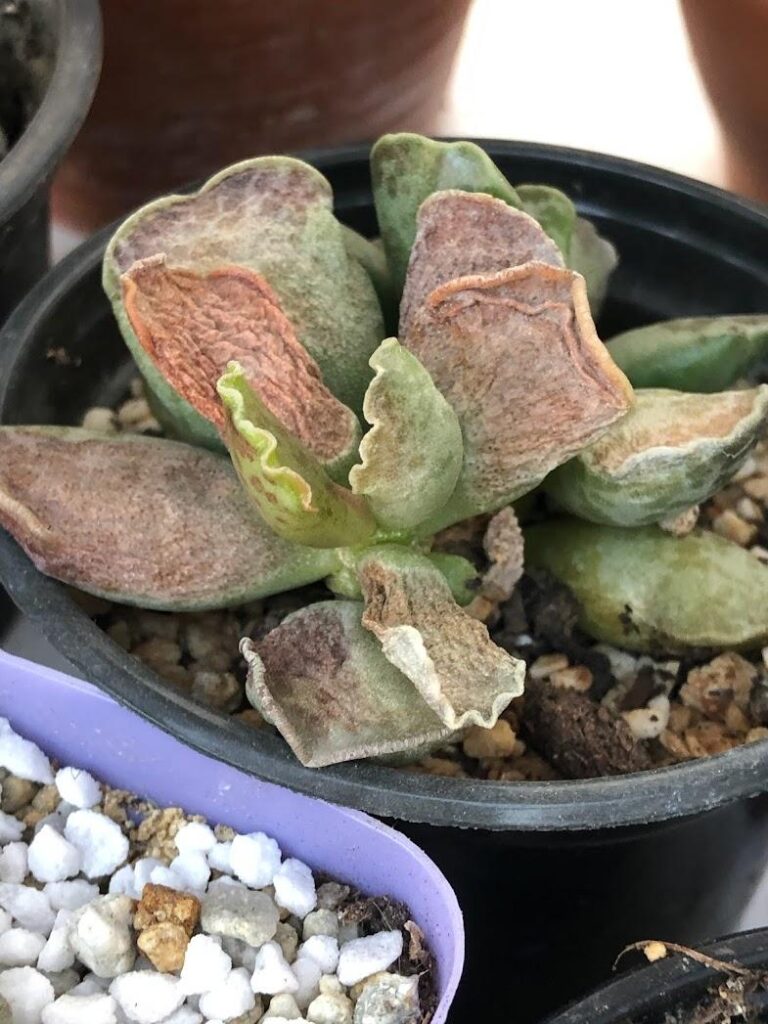
What can you do?
Do not leave new plants directly in the sun without protection in this situation. Instead, adapt your plants to sunlight by exposing them a few hours per day, increasing the timing after finding the helpful sun.
Consider covering south plants with some garden screen to filtrate some sun waves and prevent sun damage.
Please pay attention to all plants on time and move them in shadow before being burned.
If plants are seriously damaged, you might need to behead them to ensure new growth.
Underwatering as a reason for succulent brown leaves
When a plant is not watered enough, especially in the growing season, it may show not only stunted growth but also brown spots on the leaves.
You can easily recognize the under watered plant by the squeezed look of the leaves with wrinkles and vulnerability to the sun exposition.
What can you do?
Try to adapt to the soil and have a watering schedule if you have too many plants or are starting now and not having a habit.
Get information on time for the watering needs of each plant individually to create perfect time management and keep on track.
It is much better to give your plant full watering in the growing season and wait until the soil is dry than to provide smaller amounts but more often.
Brown spots on the leaves because of mechanical damage or fungal disease
Sometimes brown spots are not a result of the watering schedule being problematic.
Some brown spots occur regarding fungal infection or insect feeding, especially when the weather is changeable in spring and all insects are awake.
Snails often bite parts of the leaves, and afterward, they might change color on the damaged location. So make sure to identify and even remove those leaves because sometimes bugs can transmit diseases.
Despite insects, bad weather conditions and storms with wind, rain, or hail may cause mechanical damage on leaves or the whole plant.
From the fungal enemies, rust is one of the diseases that may harm more than one plant.
The entire plant will start having reddish-brown spots on the leaves, and infection can quickly spread to other plants you ignore and do not treat on time.
Not only rust but also when a plant has root rot, one of the first symptoms visible is changing the color of the leaves to brown and smashy.
Succulent leaves are turning yellow – common problems and solutions!
Not that rare condition when it comes to growing succulents. Usually, succulent leaves turn yellow because of a lack of soil nutrients, soil drainage, or overwatered succulents.
When you first see yellow leaves or leaf discoloration, identify the problem and avoid more issues.
Succulent soil is crucial for healthy plants and sufficient growth. Well-draining soil will prevent root rot and help in having healthy plants.
Nutrients are essential for healthy succulent plants. Mature plants will need more fertilization support because their small baby plants grow on the same steam at the beginning.
What can I do?
If you want to replenish lost nutrients, we suggest adding fresh potting mix or putting your plant in new soil at the beginning of the growing season.
Good aeration and nutritional support are necessary for a healthy plant.
In addition, another important thing is drainage holes that prevent water retention and help the soil dry quickly. Excess water usually causes yellowing and slowly is killing your plant.
During the growing season, try to follow your plant needs and add nutrients when needed depending on their size.
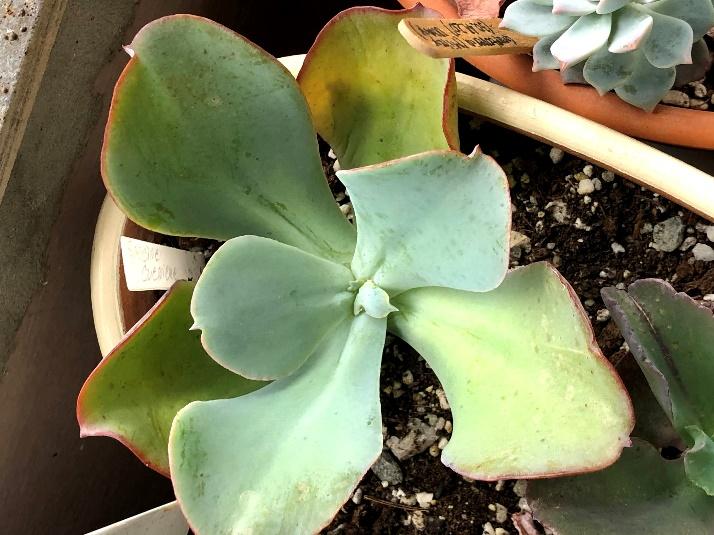
Monocarpic plants yellowing after blooming
Some succulent species tend to die after blooming, and we can say that this is a normal and unstoppable process.
This paragraph will explain the whole story and make it clear for you.
When a plant is monocarpic, that means that after the first blooming, it will die.
If you have a succulent plant with many baby plants, you might end up with a dead mother plant and save the small ones.
Examples of plants with monocarpic characteristics are the Sempervivum genus, a few Agave species, Greenovia, and others.
When blooming at monocarpic plants shows, you will see dead leaves falling, and after some period, more leaves will have yellow colors.
This process occurs because leaves give the flower all the needed nutrients and water. The plant is going under a self-destructive cycle only to be attractive enough and find pollinators (insects) that will help produce new plants.
It is a circle of life, and unfortunately, we can only try and save the baby plants or propagate the healthy leaves, but we should not and cannot stop the natural process of reproduction.
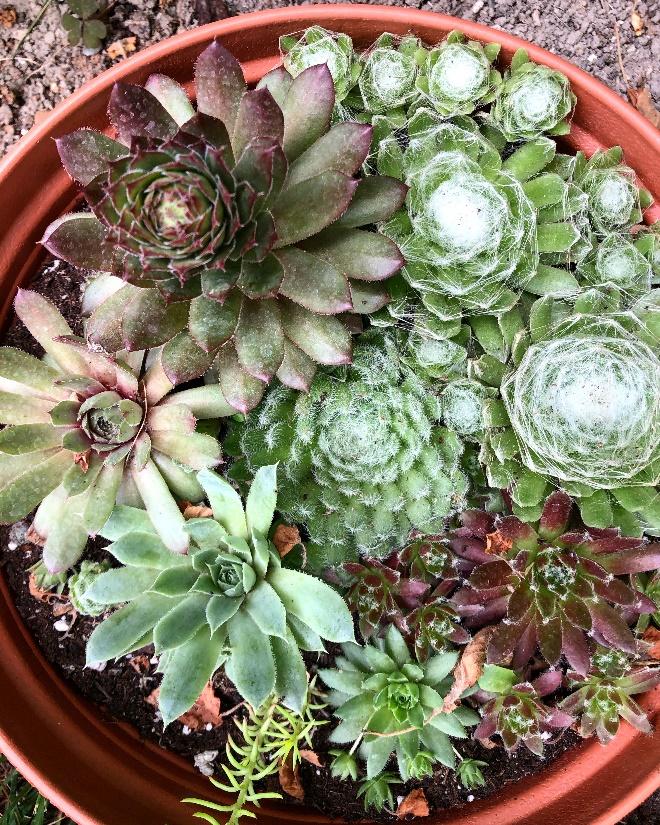
Succulent leaves are turning black- common problems and solutions!
Remember when we mentioned that yellow leaves are giving you time to evacuate your plant from the wrong soil or to stop watering?
When your succulent plant reaches a stage when the problem is more profound, leaves will start turning black, which is not very delightful since the plant is at the first emergency stage.
When you see black, soft, and not looking healthy leaves, immediately try to eliminate the problem and enable healthy surroundings for your succulent.
As we mentioned before, succulents in such situations are dying because of too much water or bad soil mix.
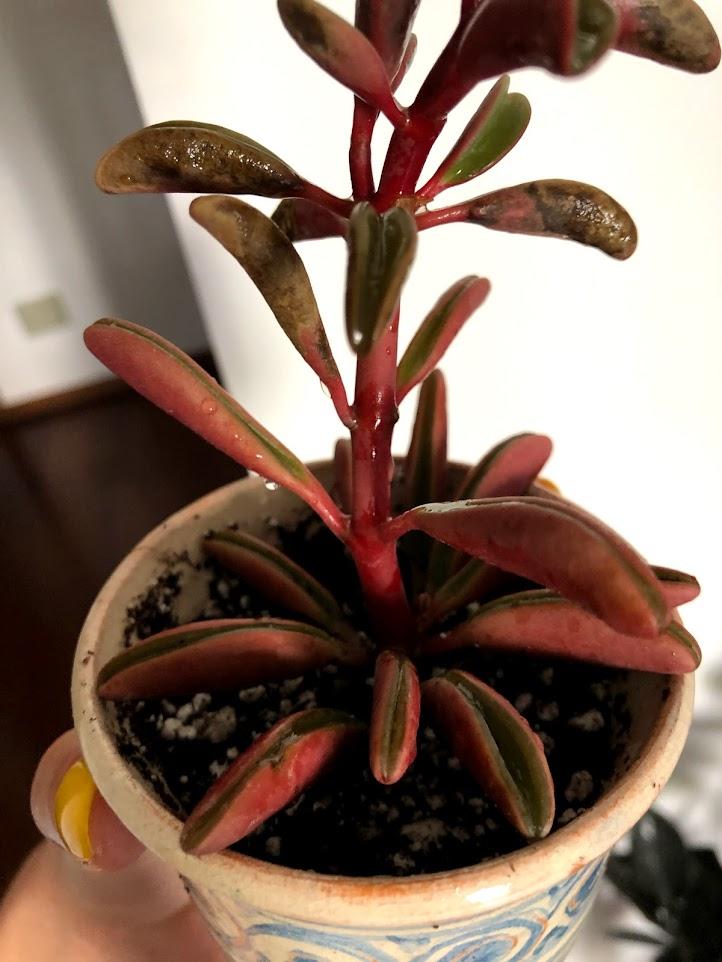
What to do?
First, try to pull off the damaged leaves because you want to stop spreading a fungal infection if present.
Another thing you might do is to take off your plant from the soil, check the roots and wash them if they are still here and let your plant dry a couple of days before replanting.
If you use the same pot, disinfect it before adding soil and assure that soil dries quickly.
Process of growing new succulent leaves
Since in this article, we give you the advice to pull the bad leaves off your succulents and now we will explain what happens afterward.
Whenever you do some mechanical damage to the healthy plant tissue, the process of regeneration starts (same as humans when they got injured).
Where old leaves fall, plants will either give plant babies or grow new leaves back, and some people intentionally use this technique to make plants look richer.
Using hormones for growth should be intense in the growing season, so every plant damage on the healthy part of the plant will induce new leaves or plants.
After knowing all this information, we believe saving your plant now looks reliving and wonder what happens after saving steps.
RELATED: How to Get Rid of Mold on Succulents: A Comprehensive Guide
Different propagation methods for growing new succulents
Succulent propagation is widespread worldwide because it can bring us more succulents and covered pots with beautiful mixes of plants.
The propagation process is often used to save plants from damage or multiply your favorite plant.
As we agreed above in the text, some damages are so severe that you have to propagate your plant again before it is too late.
There are different methods of propagation known as successful, so here we are going to explain more about the most used ones:
Propagation from leaves
Usually, all healthy leaves are in use to produce new succulents. However, newly propagated plants at the beginning will need more watering since their tissues cannot hold the water as much as mature plants.
To propagate this way, you can use different techniques such as water propagation in plastic bottles, propagation on the soil surface, propagation in perlite, pumice, etc.
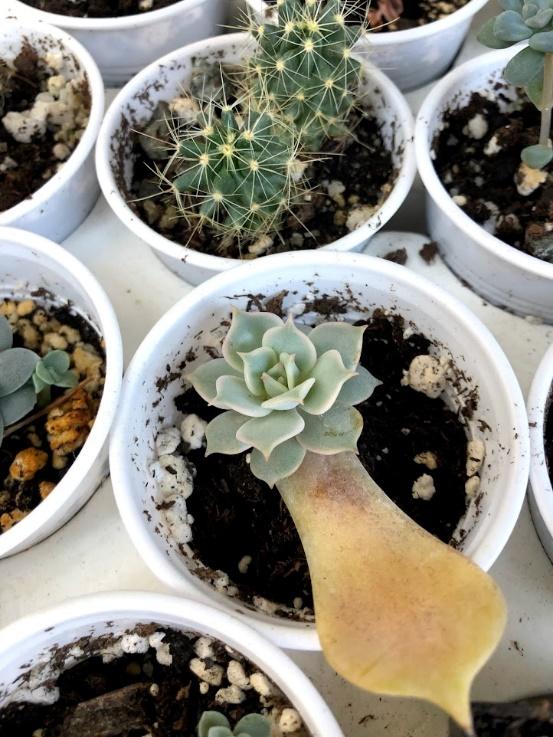
Propagation from cuttings
Cuttings, for sure, are an easy and successful way for faster growth. Small pieces of the plant are taken from the healthy parts and left aside to dry a couple of days before placing them into the ground.
Never take a cutting from parts with dead tissue because it will not result in roots, and the mission will not be successful.
After placing the cuttings into the soil, do not water them immediately and leave them to adapt to the new surroundings.
Propagation with beheading
In not-so-perfect conditions, beheading might be the only way to save your plant from fungal disease or other irreversible damage.
When a plant is beheaded, the upper part – the head should be left to dry and then placed in drainage soil to root.
Usually, if you do the right thing, the head will have roots in about two weeks, make sure to check, and if not rooted, maybe you will need to cut again depending on the health status.
Water propagation
When you get a cutting or upper part beheaded, it is possible to use this method since it shows good results quickly.
Pour some water into a suitable container and put the cutting steam inside it. After a short period, you will realize new white roots, and your plant will be ready for ground potting.

RELATED: Let There Be Light! How Much Light Your Succulents Need To Grow
frequently Asked Questions
We know that even though this article gives a lot of new information, there might still be some questions to be answered.
Because of this, we are responding to the most frequent questions connected with this topic.
Can yellow leaves turn green again?
Once your plant leaves lose the chlorophyll (the substance responsible for the green pigmentation), the leaf discoloration will continue till the leaves drop.
It is impossible to save yellowed leaves since they lack nutrients and are on the way to dying.
Which nutrient deficiency gives the leaves yellow color?
It depends on what part of the leaves starts to yellow first. For example, tips and edges signal Iron deficiency, while nitrogen in most cases gives the yellow color of succulent leaves if that is the reason for changing color.
Should I remove yellow leaves on succulents?
We do not suggest taking off dying leaves at any cost. Here is why.
When you notice yellowing from the bottom of the plant, your succulent needs fertilization or has too much water in the soil.
In both cases, leaves will prevent damage from spreading to the whole plant and keep the problem at local levels until you react to the change.
Learn much more about succulent problems and how to manage them.
We are sure you do not want those overwatering symptoms to turn into rooting rot and fungal infection.
Why is the stem of my plant turning brown?
Sooty black mold is the common reason for this problem. However, fungal infections await the next victim when warm temperatures hit and most succulents thrive in their growing season.
Rain increases the humidity level during sunshine days and gives all fungal infections the green light to start attacking your plants.
We mentioned beheading as a way for propagation, and we suggest as soon as you realize the stem is turning black, cut off the head of your plant and place it in water or soil, depending on the chosen method.
After we have explained in detail all the situations you might have when choosing succulents as your hobby, we expect you to stay with us for more valuable articles and advice on how to care for your chubby plants.
Editor’s Recommendations
Now that you know why are the leaves on my succulent turning brown, make sure to read our other succulent articles:
Realize Common Fungal Infections on Succulents and How to Treat Them
Learn Easy Ways on How to Take Care of Succulents
Step by Step Guide to Preparing a Perfect Potting Mix for Your Succulents







